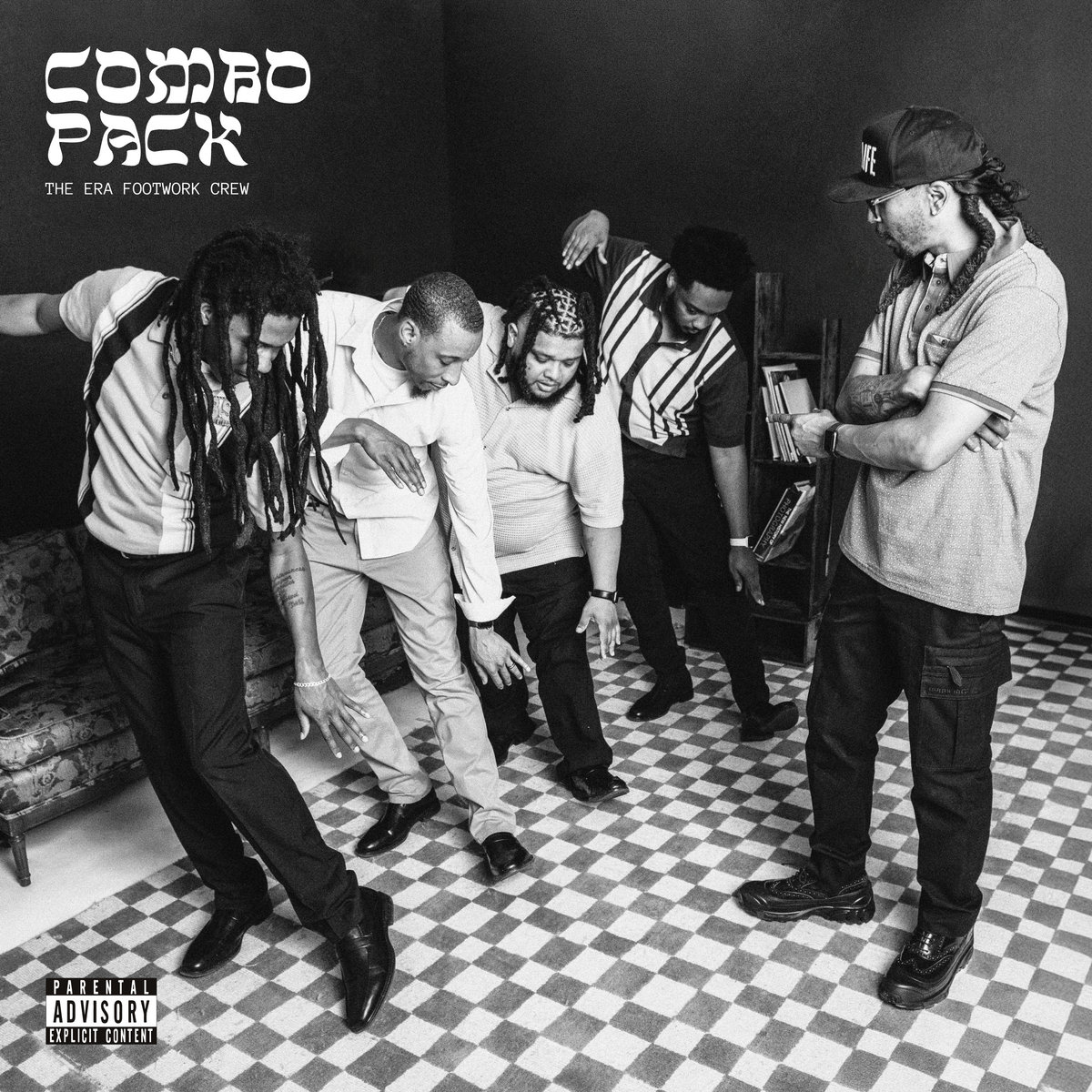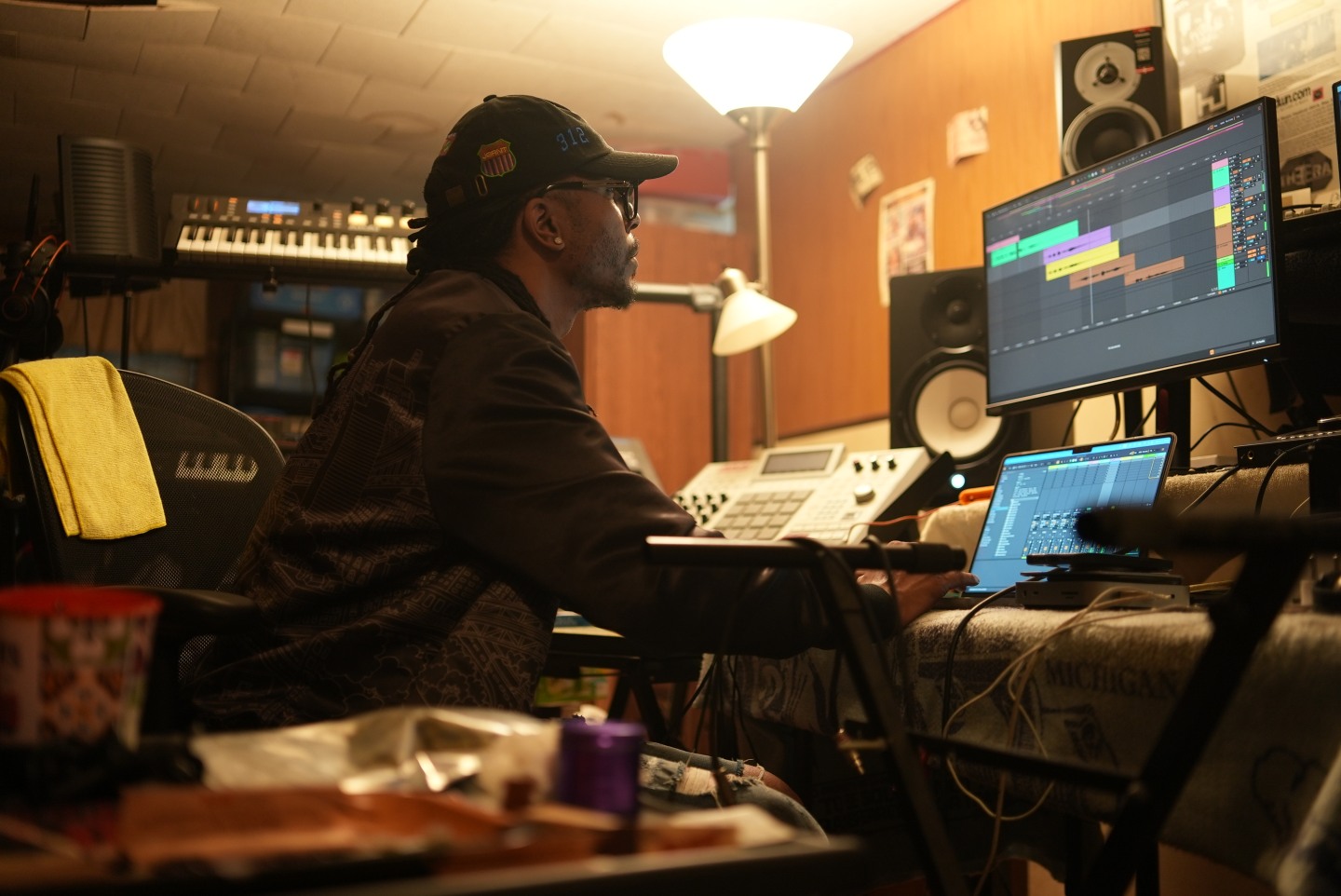 Courtesy of The Era
Courtesy of The Era
There’s a moment in Robert Townsend’s Motown-inspired film The Five Heartbeats in which Sarge, the titular vocal group’s newly appointed (and visibly drunk) choreographer, meets the group for the first time and immediately demands to see their “best combination.” Dresser, the Heartbeat who’d originally been devising their routines up until that point, answers the challenge, less than enthused about ceding his role. Sarge is unimpressed, tossing his cane and jacket to the side to bust out a wild combination of moves that spans the entire living room floor. It’s clear he’s suited for the job: Cue training montage.
This fictional exchange served as the primary inspiration for Combo Pack, the second EP by Chicago footwork supergroup The Era and their first official release on the Teklife label. The scene doesn’t just appear as sampled dialogue on the record’s final cut, “We Gone Step,” priming listeners to let it all out on the dancefloor before time runs out; it’s also referenced in the EP’s greyscale cover art, which shows producer DJ Spinn coaching The Era’s four members through their steps as dancers and rappers during the recording process.
“We were always telling each other, ‘show us your best combination,’” Chief Manny tells The FADER over the phone. “It was this idea that people today don’t really know how to put a combination together in footwork; they only have the foundation. We wanted to bring that same concept into the music and put a combo pack together.”
Though vocals have always been an integral element of footwork music, they’ve traditionally been used as raw material for beatcraft, with producers inserting sliced portions of sampled chants and phrases throughout their drum patterns. On Combo Pack, however, The Era apply a concrete narrative to their songs, using contemplative chord progressions and nervy 808 kicks as set-dressing to reminisce on the crew’s 10th anniversary together. “I remember it cost ten to get in,” Litebulb raps on “Time,” which flashes back to the footwork battles of their youth. “At the party, cook his ass, still ain’t guaranteed to win.”
When I hop on a video call with Chief Manny and Litebulb, it’s clear that the sense of nostalgia persists. They’re gearing up for the Combo Pack release party on November 23, set to take place at a to-be-announced secret location they’ve dubbed “Granny Crib.” “We’re recreating what it’s like to be in your granny’s crib,” Litebulb says. “That’s where we used to practice.”
Ahead, Chief Manny and Litebulb look back on The Era’s evolution as footwork polymaths, from their earliest mixtape releases to their efforts to garner respect as performers.
 The cover of The Era's Combo Pack EP.
Spencer Hopkins/ashes57
The cover of The Era's Combo Pack EP.
Spencer Hopkins/ashes57
The FADER: The Era started releasing music in 2016 with your In the Wurkz mixtape. What inspired you to start rapping as a group?
Litebulb: I had already been traveling and touring with DJ Spinn and DJ Rashad for a couple years, and we ain’t really had a planned-out set yet. We were just doing shit from the crib, like, they’d be playing tracks while I just got up there and did what the fuck I do with no routine. But I got tired of doing that shit. We had to find a way to hold these crowds over for an hour without me having to dance the whole time; dancing for an hour straight just ain’t it, especially with footwork, which is such a pulverizing dance.
[Chief] Manny was about to have a son, and me and him were thinking about how we could push our artistry to a different level. Manny said we should try to write music and really get into that shit. We not gonna be good when we start, of course, but we know who we want to aspire to be, like the Kendricks and J. Coles of the world. We kept working, and the goals started materializing and transforming.
Chief Manny: Litebulb won a CDF [Chicago Dance Forum] Lab Artist Award in 2015, and we had to make a stage show for that. That was where we were first getting into music. We were also doing footwork music videos as another way to really engage audiences, not just with the battles. We did an In the Wurkz mixtape and an In the Wurkz stage show… Basically everything was In the Wurkz. We even did Windy City Live.
Litebulb: Yeah, we did do that [laughs].
Chief Manny: Everybody kept saying, “Y’all ain’t rappers,” and we weren’t really even trying to be rappers there. We were just trying to create another lane for ourselves and potentially for other people to push the artistry of footwork.
“People today don’t really know how to put a combination together in footwork. They only have the foundation.”
On those early releases, you were hopping on tracks by guys like DJ Manny, DJ Rashad, and DJ Earl. What was the collaboration like?
Litebulb: Footwork is one of those things that’s evolved, so it’s come from house to ghetto house, to juke, and then to footwork. At the time we were coming up, this was another evolution in the artistry. In all honesty, the DJ’s weren’t really…
Chief Manny: Nobody was fucking with us [laughs].
Litebulb: This was a time where all the DJs were traveling and touring. They were the ones getting shows booked. So for us, pushing something different, they weren’t ready for that. But we were going to do the music regardless. We paid the DJs to get us tracks to produce. We were going over to DJ Phil’s crib and working with DJ Manny, trying to do this stuff seriously. It got to the point where we’re like, “Let’s take tracks that’s already been made, some unreleased, some already out, and nobody’s gonna stop the train of us doing what we want to do.”
Chief Manny: Where would we be if we listened to people? Not where we are now. People know us for hardcore battling or being the top footworkers in the city, so hearing our voices on the track was fucking people up. DJ D-Man, who made that track “Dooky Booty,” he fucked with us. He let us record in his crib and helped us get our music the best it could be. Even though it wasn't us at our top level or us as the best writers, we still put together a solid project that had good artwork and a storyline. 90% of the footwork albums out there, it’s just some random label — respect to the labels, though — that get artists to make tracks with no story behind them. We wanted our music to have a story behind it.
People don’t understand that footwork has a voice; they just don’t get to hear it. We were broke as hell doing this, but we want people to understand that you can prevail.
 DJ Spinn
Courtesy of The Era
DJ Spinn
Courtesy of The Era
 Courtesy of The Era
Courtesy of The Era
 Courtesy of The Era
Courtesy of The Era
That’s what I found interesting about Combo Pack. Footwork traditionally has some sort of vocal in it, but by rapping you’re able to go in depth with some biographical details.
Chief Manny: Usually, when you do have a dancer that makes music, it’s a slide or, like, “This is the ‘so and so’ dance.” You don’t get the hardcore dancers talking about hardcore battling.
DJ Spinn produced the majority of this new EP. How’d you get so connected with him?
Litebulb: We did this interesting-ass festival called Eaux Claires in Wisconsin with him. It was like some Kanye West in Wyoming type shit. They had this full base to work on whatever music we wanted to. All these people we knew like Noname and Peter CottonTale were there. Spinn was with us, too, so the music just came together.
Chief Manny: We had this idea of rapping on Reasonable Doubt samples, and we made this track called “The Come Up.” The first solid track we made with Spinn, though, was “She Pick the Speed.”
Litebulb: When COVID happened and shut down our non-profit, we were gonna rebuild the entire organization and see where we’re at in two years. That’s when the first version of “We Gone Step” with Spinn came, then “160,” then Combo Pack. It came in this relaunch phase of us redefining our sound and the way we write music.
What makes Spinn’s production style so special?
Litebulb: He knows how footwork is supposed to sound. Not even supposed to sound, but just sounds. He’s got this soulful connection to music where he can find amazing sounds and put them together to make beautiful footwork. It takes a minute, but when he gets it, it’s some of the best music you’re gonna hear.
Chief Manny: He’s a superfan of a lot of old-school music. He’d put some shit on and give us a whole rundown on it. We got this knowledge from his generation and his mama’s generation. In terms of his sound, he’s got this smooth, player-ass energy.
I really liked his interpolation of Nas’ “The World Is Yours” on “Who Betta.” I also liked the line, “Write some grants and make some racks.” You don’t often hear a bar about grant writing.
Litebulb: I think people fuck with what we’re saying because it’s different. People don’t talk about grants, but as a dancer coming up, before you get to anything else you better learn how to write a grant. It ain’t guaranteed you’re gonna win it, and that’s a struggle.
“People don’t understand that footwork has a voice. They just don’t get to hear it.”
You’ve mentioned the evolution of footwork a few times. Where do you think the art form is going in the future?
Chief Manny: It’s already spreading around the world. The music really spread big first, and now the dance has spread into a lot of other states and countries. It’s to the point where you’ve got DJs making albums and doing club sets, and then you’ve got dancers teaching and battling. What we want to do as artists is push the artistry to an audience who don’t necessarily take straight to the music or don’t want to battle.
Litebulb: I’m producing a whole art exhibition around the foundation of this [footwork] move [called] “the ghost.” Manny’s producing one of the first films about footworking and storytelling. Steelo’s doing fashion. P-Top’s putting a URL event together. Diving into music and storytelling on tracks is our way of trying to build a real fanbase again for footwork, which DJ Rashad and Spinn started to build, and continuing that trajectory. Footwork has never really had the resources or machines that other genres of art have, but over the past few years we’ve made tremendous strides to get footwork seen and respected.
This interview has been edited and condensed for clarity.